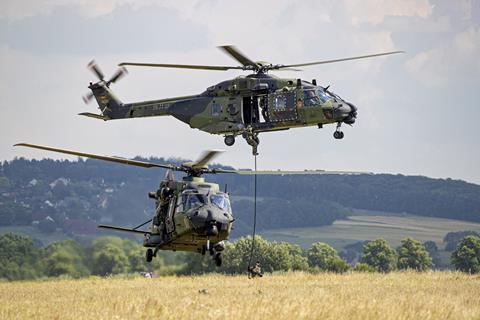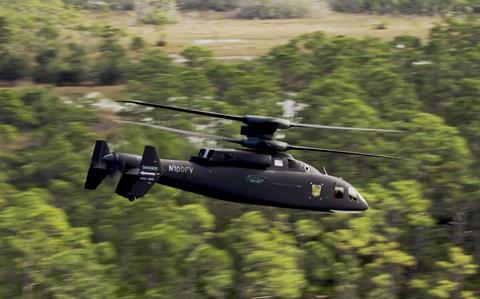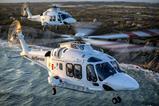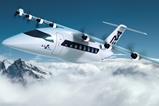Prospective bidders for a NATO contract seeking concept design studies for a next-generation rotorcraft are preparing to deliver their responses to the alliance’s latest tender, a process that could see new industrial teams forming.
Released on 2 February, the request for proposals (RFP) from the NATO Support and Procurement Agency (NSPA) calls for the industry to “explore the art of the possible” in delivering concepts under the Next Generation Rotorcraft Capability (NGRC) programme.
Three prime contractors will be selected by July, with the goal to deliver completed studies by late 2025.

Led by six European NATO members – Canada also is waiting in the wings to join – the NGRC effort aims to deliver a new rotorcraft in the 2040s to replace thousands of legacy helicopters currently in service.
If it progresses to the development stage, the NGRC will be one of the biggest international rotorcraft programmes in the coming decades and already has helicopter manufacturers jostling for position.
A virtual meeting with industry held shortly after the tender was released was attended by around 40 representatives from 15 companies, the NSPA says.
Although the agency declines to disclose their identities, it is almost guaranteed that the industry’s big four – Airbus Helicopters, Bell, Leonardo Helicopters and Sikorsky – participated.
While US manufacturers Bell and Sikorsky are likely to offer versions of their respective tiltrotor and coaxial-compound designs, it is unclear whether the two European manufacturers will join forces, go it alone, or seek an alliance with one of their transatlantic counterparts.
Airbus appears wedded to a version of the architecture that will shortly fly on the Racer high-speed technology demonstrator – it features a single main rotor and twin pusher-props mounted on V-shaped box-wings – while Leonardo is a fierce advocate for tiltrotor aircraft.
However, David Alfano, head of next-generation military rotorcraft at Airbus Helicopters, notes that the NSPA will allow a winning bidder to submit two separate designs as part of the concept study process. “So we can propose both,” he says. “We are open to co-operation.”
“We plan to bid a fully joint European answer,” he says, adding: “we would favour an answer with Leonardo.”
He points out that the NGRC nations – France, Germany, Greece, Italy, the Netherlands and the UK – are all familiar customers of both companies, plus of the NH Industries consortium they own alongside GKN/Fokker.
“We have a pretty good knowledge of what they have today and what they ask to be prepared in the next-generation platforms,” he says.
Although likely to use technology from the Racer project, as a civil technology demonstrator, Alfano points out that it “cannot be a copy-paste – we will have to adapt [the design]”. But the architecture will allow a rotorcraft to fly “fast, low and far”, offering “state of the art manouevrability”, he adds.
Alfano even sees a path to Airbus participating in a tiltrotor project alongside Leonardo if that was the architecture preferred by the NGRC programme. “If it’s the way to go, then why not?”
Jerome Combe, head of product policy at Airbus Helicopters, adds: “We are very clear with Leonardo: our will is to go together to deliver a European solution to a NATO requirement.
“There is no religious reason for us not to go for tilt if this was the choice of our nations. We are willing to go hand in hand with Leonardo whatever solution is favoured.”
But it as yet unclear if those feelings are reciprocated by its Italian counterpart: “At this stage Leonardo is assessing all possible options,” the airframer says when asked if it is contemplating a joint bid.

Elsewhere, Bell has “been closely watching the NATO NGRC initiative and is assessing the RFP”, the US airframer says.
“We do believe tiltrotor is a strong solution to the requirements laid out in the RFP but will make a decision in the near future.”
Given the common tiltrotor approach, it is also not out of the question that Leonardo and Bell could seek an alliance. A clearer indication of the Italian company’s position could come later this week at the Heli-Expo show in the USA.
Bell approaches the tender from a position of relative strength, with its V-280 Valor tiltrotor having been selected last year by the US Army for its Future Long Range Assault Aircraft (FLRAA) programme to develop a long-term replacement for the Sikorsky UH-60 Black Hawk.
But the same cannot be said for Sikorsky: its coaxial-compound Defiant X lost out to the V-280 in the FLRAA contest and it saw hopes dashed for the smaller Raider X, based on the same X2 technology, when the US Army decided to axe the Future Armed Reconnaissance Aircraft programme.
Despite the lack of success in its home market, Sikorsky is keen on the NGRC requirement. “We remain confident that X2 technology is the right solution to meet international mission needs now and in the future,” says Luigi Piantadosi, director of Future Vertical Lift, international at Sikorsky.
“We look forward to participating in Study 5 and continuing to work with NATO to develop its NGRC requirements as our X2 rotorcraft will provide the speed, maneuverability and survivability to meet those requirements with a next-generation capability.”
The NSPA has already awarded two concept study contracts, to GE Aerospace and Sikorsky, respectively for propulsion and the rotorcraft’s open systems architecture.
Although there is as yet no clarity on the potential for collaboration between Airbus and Leonardo for NGRC, the two manufacturers are already working together on a separate European Defence Fund-backed initiative.
Under that effort, the EU Next Generation Rotorcraft Technologies (ENGRT) project, the pair are leading a large consortium of aerospace firms, drawn from eight nations, to identify and mature the technologies needed for a future rotorcraft.
Having received an initial concept of operations (conops) from participating countries – the five EU members from the NGRC effort, plus Finland, Spain and Sweden – work has begun under the project’s first phase.
Running for a total of 42 months, starting in early 2023, discussions are already under way regarding whether a follow-on step could be required, potentially including flight tests of relevant systems.
Technologies spun out of the ENGRT work could also be fed back into the NGRC programme, adds Alfano.
“At the end, the idea is to provide solutions to our customers for them to be more confident and for them to have not only addressed the conops and the feasibility of what they ask, but as well as some technology maturation relevant enough to go for the next steps beyond 2030,” he says.



















































